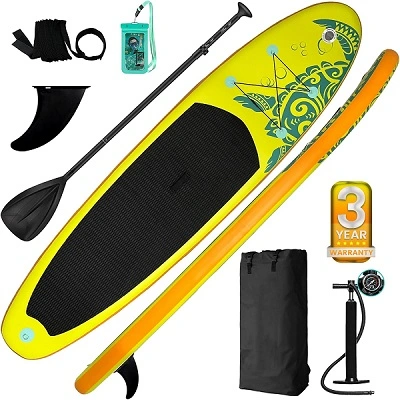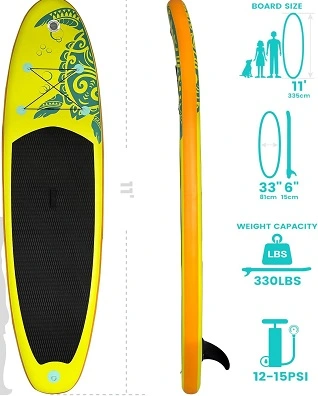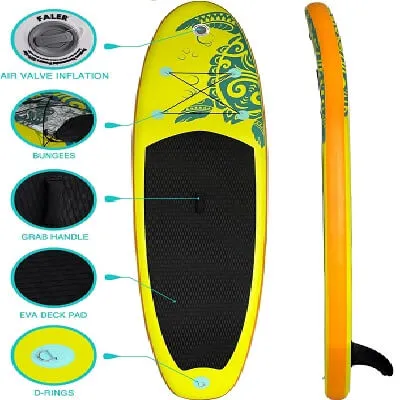Inflatable paddle boarding
Discover the joys of Inflatable Paddle Boarding with our detailed guide. Learn everything from the basics to advanced techniques. Find expert tips and FAQs for a delightful paddleboarding experience.
Embark on an exciting aquatic adventure with paddleboarding. This comprehensive guide covers all aspects, ensuring you’re well-equipped to navigate the waters. From setup to advanced techniques, let’s dive into the world of inflatable paddle boarding.

Product information
| Item Package Dimensions L x W x H | 35.5 x 15 x 8.75 inches |
| Package Weight | 12.09 Kilograms |
| Brand Name | FunWater |
| Color | Yellow |
| Material | Polyvinyl Chloride (PVC) |
| Included Components | No |
| Sport Type | SUP Paddling, Surfing |
| Store |
$159.22
Table of Contents
Description
Inflatable paddle boarding, often abbreviated as iSUP, is a thrilling water sport that has gained widespread popularity in recent years. It involves participants standing on a large, stable inflatable board and using a paddle to navigate through various water environments. The key distinction of inflatable paddle boards is their portability and convenience.
What sets inflatable paddle boards apart is their remarkable portability. Easily inflatable and deflatable, these boards can be rolled up and stored in a compact case, making them ideal for travel and storage. Despite their inflatable nature, modern boards are crafted from durable materials, ensuring stability and performance in various water conditions. Versatile and adaptable, inflatable paddle boards are suitable for serene lakes, meandering rivers, and even challenging ocean waves.
Their user-friendly design, affordability, and accessibility make them an excellent choice for both beginners and experienced paddlers, providing a thrilling and convenient way to explore the waters.
Comprehensive Guide
Introduction
Embark on an exciting aquatic adventure with Inflatable Paddle Boarding. This comprehensive guide covers all aspects, ensuring you’re well-equipped to navigate the waters. From setup to advanced techniques, let’s dive into the world of inflatable paddle boarding.
Understanding Inflatable PaddleBoarding
Inflatable paddle boarding, a versatile water sport, offers portability and durability. These boards, crafted from robust materials, provide stability and are perfect for various water conditions. Discover the convenience of inflating and deflating, making them ideal for travel and storage.
Choosing the Right Inflatable Paddle Board
Explore factors like board size, thickness, and fin setup. Tailor your choice to your skill level, body weight, and intended use. Dive into the world of LSI Keywords, ensuring your selection aligns with your paddleboarding preferences.
Inflating Your Board: A Step-by-Step Guide
Master the art of inflating your paddleboard efficiently. Utilize the provided pump to achieve optimal pressure. Ensure a firm and stable board for a safe and enjoyable experience on the water.
Paddling Techniques for Beginners
Start your paddleboarding journey with proper techniques. Learn how to stand, paddle, and turn effectively. Embrace the initial wobbles, gradually gaining confidence and balance. I will suggest to learn Paddle Boarding (SUP) For Beginner,
Exploring Water Environments
Discover the versatility of inflatable paddle boards in various settings. Whether gliding on calm lakes, navigating gentle rivers, or riding ocean waves, these boards adapt to different water conditions, offering a thrilling experience.
Advanced Paddle Boarding: Tips for Experienced Riders
Level up your skills with advanced paddleboarding techniques. Master turns, pivot smoothly, and explore challenging waters. Elevate your inflatable paddle boarding experience with expert tips from seasoned riders.
Safety Measures on the Water
Prioritize safety with essential guidelines. Equip yourself with a life jacket, understand weather conditions, and be aware of your surroundings. Ensuring safety enhances the enjoyment of inflatable paddleboarding.
Inflatable Paddle Boarding Accessories
Explore accessories like paddles, ankle leashes, and waterproof bags. Elevate your paddleboarding experience with the right gear, enhancing comfort and performance on the water.
Family-Friendly Activity
Discover the joy of paddleboarding as a family. Explore inflatable paddle boards suitable for all ages, fostering a shared love for water adventures. Strengthen bonds while enjoying the great outdoors.

Paddle Boarding (SUP) For Beginner
Pros
- Portability:
- Pro: Inflatable paddle boards are highly portable. When deflated, they can be rolled up and easily transported in a backpack, making them convenient for travel and storage.
- Durability:
- Pro: Modern inflatable paddle boards are crafted from durable materials such as PVC or drop-stitch construction, making them robust and able to withstand normal paddleboarding activities.
- Versatility:
- Pro: Inflatable paddle boards are versatile and suitable for various water conditions, including lakes, rivers, and oceans. They are designed for stability, making them a good choice for beginners.
- Ease of Use:
- Pro: Inflatable paddle boards are generally easy to inflate and deflate. Most come with a pump that allows users to quickly inflate the board to the recommended pressure.
- Storage:
- Pro: Inflatable paddle boards are an excellent option for people with limited storage space. When deflated, they take up minimal space and can be stored in small closets or even the trunk of a car.
- Affordability:
- Pro: Inflatable paddle boards are often more affordable than hard boards, making them accessible to a broader range of users.
Cons
- Performance:
- Con: Inflatable paddle boards may not provide the same level of performance as hard boards, particularly in high-performance activities like surfing. They may lack the same speed and responsiveness.
- Rigidity:
- Con: While modern inflatables are sturdy, they may not be as rigid as hard boards. This can affect the overall feel and responsiveness, particularly in choppy or wavy conditions.
- Inflation Time:
- Con: Inflating the paddle board can take a few minutes, which may be seen as a drawback compared to the quick launch of a hard board.
- Weight Capacity:
- Con: Inflatable paddle boards may have lower weight capacities compared to hard boards. This limitation could impact the suitability for heavier riders or those carrying additional gear.
- Puncture Risk:
- Con: While durability is a pro, there is still a risk of punctures or damage to the inflatable material, especially in rocky or sharp debris-filled waters.
- Surface Feel:
- Con: Some paddlers prefer the traditional feel of a hard board on the water. Inflatable paddle boards may have a different feel due to their softer surface.
Choosing the Right Inflatable Paddle Board
Understanding Dimensions and Shape
When selecting an inflatable paddle board, consider its dimensions. A longer board provides better speed, while a wider one enhances stability. The shape also matters – a rounded nose is excellent for all-around use, while a pointed nose is preferable for speed and maneuverability.
Material Matters: PVC vs. Drop-Stitch Construction
Inflatable paddle boards are primarily made from PVC or feature drop-stitch construction. PVC boards are lighter, while drop-stitch construction provides enhanced rigidity. The choice depends on your priorities – portability or performance.
Stability and Skill Level
For beginners, stability is key. Look for boards with a wider base and thicker construction. Advanced paddlers may prefer narrower boards for increased maneuverability. Always check the weight capacity to ensure a comfortable ride.

Components
Drop-Stitch Core
- The core of an inflatable paddle board is typically constructed using a drop-stitch material. This technology involves thousands of threads connecting the top and bottom layers, creating an air-tight compartment. The result is a board that can be inflated to high pressures, offering rigidity and stability.
PVC (Polyvinyl Chloride) Material
- The outer layer of most inflatable paddle boards is made from PVC. This material provides durability, resistance to abrasions, and ensures the board’s longevity. Look for high-quality PVC to ensure the board can withstand various water conditions.
EVA Foam Deck Pad:
- The top surface of the inflatable paddle board features an EVA foam deck pad. This non-slip, cushioned pad provides comfort and grip for the paddler, ensuring a stable footing even in wet conditions. The deck pad is crucial for maintaining balance and control.
Military-Grade Drop-Stitch Construction:
- Some premium inflatable paddle boards feature military-grade drop-stitch construction. This means the drop-stitch core is reinforced with additional layers of PVC, enhancing the board’s strength and durability. Boards with this construction are often suitable for more demanding water activities.
Valve:
- Inflatable paddle boards come equipped with a valve for easy inflation and deflation. The most common type is the Halkey-Roberts valve, designed for a secure airtight seal. This valve ensures a quick setup and breakdown process, making the board convenient for users.
D-Rings and Bungee Cords
- D-rings, typically made of stainless steel, are strategically placed on the board to attach accessories or secure cargo. Bungee cords connected to these D-rings provide a practical storage solution for items like dry bags, water bottles, or gear, enhancing the board’s versatility.
Fins
- Inflatable paddle boards come with a set of fins that play a crucial role in stability and tracking. The configuration and size of the fins vary between models. Larger center fins enhance tracking, while smaller side fins improve maneuverability. Some boards feature removable fins for easy transportation and storage.
Carry Handles
- Multiple carry handles are positioned on the board to facilitate easy transportation to and from the water. Typically made of robust nylon, these handles allow users to comfortably carry the inflated board, whether alone or with a partner.
Pump
- An inflatable paddle board is accompanied by a hand or electric pump for inflation. The pump is designed to efficiently inflate the board to the recommended pressure, ensuring optimal performance on the water. Look for boards that come with a high-quality pump for convenience.

Installation of Inflatable Paddle Board
Choose a Suitable Location
- Select a flat and clean area to set up your inflatable paddle board. Ensure there are no sharp objects or debris that could potentially damage the board during inflation.
Unpack the Board
- Remove the inflatable paddle board from its storage bag. Lay it out on the ground with the top (deck) facing upward.
Inspect the Board
- Before inflation, inspect the board for any visible damage or issues. Check the seams, D-rings, and valve to ensure everything is in proper condition.
Attach the Fin(s):
- If your inflatable paddle board has removable fins, attach them according to the manufacturer’s instructions. Fins enhance stability and tracking in the water.
Locate the Inflation Valve:
- Identify the inflation valve on the board. Most inflatable paddle boards use a Halkey-Roberts valve. Ensure the valve is in the closed position.
Prepare the Pump:
- If your board comes with a hand pump or an electric pump, prepare it for use. Connect the pump hose to the inflation valve, ensuring a secure fit.
Inflate the Board:
- Begin inflating the paddle board using the pump. For hand pumps, use steady and consistent strokes. For electric pumps, follow the manufacturer’s instructions for optimal inflation. Inflate the board to the recommended PSI (pounds per square inch), typically specified by the manufacturer.
Check for Firmness:
- Once the board is fully inflated, check its firmness by pressing down with your thumb. It should feel rigid with a slight give. Avoid overinflating, as this can damage the board.
Secure the Valve Cap:
- Close and secure the valve cap to ensure an airtight seal. This prevents air from escaping and maintains the board’s pressure.
Attach Accessories:
- If your inflatable paddle board has D-rings for accessories, such as a leash or cargo net, attach them as needed.
Position the Board in the Water:
- Carry the fully inflated paddle board to the water’s edge. Place it in the water with the fins facing downward. Ensure the board is floating freely.
Mount the Board:
- With the board in the water, carefully mount it by kneeling or standing near the center. Find your balance before attempting to paddle.
Adjust Paddle Length:
- Adjust the length of your paddle according to your height. A general guideline is that the paddle should be around 6 to 10 inches taller than the paddler.
Paddle Safely:
- Start paddling in a kneeling position before standing up. Paddle at a comfortable pace and enjoy your inflatable paddle boarding adventure.


Conclusion
Inflatable paddle boarding offers a delightful blend of convenience, durability, and versatility. Whether you’re a beginner seeking a stable learning platform or an experienced rider craving portability, inflatable paddle boards provide an enjoyable and accessible way to explore the water. Embark on your water adventure, ride the tides, and discover the wonders of inflatable paddle boarding.
FAQs
How long does it take to inflate an inflatable paddle board?
Inflation times vary but typically range from 5 to 10 minutes, depending on the pump’s efficiency and the board’s size.
Are inflatable paddle boards suitable for beginners?
Absolutely! Inflatable paddle boards provide excellent stability, making them ideal for beginners to learn and enjoy paddleboarding.
Can inflatable paddle boards be used for yoga?
Yes, many inflatable paddle boards are designed with stability in mind, making them suitable for yoga and other fitness activities on the water.
What is the weight capacity of inflatable paddle boards?
Weight capacities vary by model, but generally range from 200 to 300 pounds, accommodating a wide range of riders.
How do I store my inflatable paddle board when not in use?
Deflate the board, roll it up, and store it in the provided backpack or carrying case. Keep it in a cool, dry place.